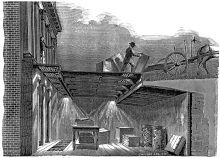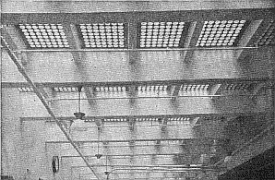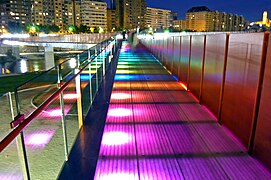Pavement light


Pavement lights are usually put into sidewalks or floors to let sunlight into a room below it. They are sometimes called vault lights or sidewalk prisms. They were much used in the late 19th and early 20th centuries when electric lighting was very expensive. Some cities are removing these lights, but others are keeping and restoring them.
Uses[change | change source]
Pavement lights give sunlight into the basements below it during the day, and the basement gives light to the sidewalk from below during the night.[1] These lights are meant to make basements more useful in cities and places where space is scarce.[2] In places with high rent, these lights may make an area look better, which helps landlords make more money. People with these lights can also save on electricity during the day, because the lights are clear like a window, where sunlight can go through.[3]
Many years ago, pavement lights were advertised as a way of saving on electricity costs and making places look better.[3] Today's science has proven that they were right.[4]
Pavement lights are also used in floors with glass roofs. They could be put in a floor below another floor with more pavement lights, letting sunlight go through more than one floor.[5] Manhole covers were also made with pavement lights.[2]
Most old cities have pavement lights, or at least, they have had them in the past.[6] These lights are about 100 years old.[2] However, some new pavement lights are being made, even today.[7]
Pictures[change | change source]
-
An example of pavement lights.
-
The same lights at night, used to shine light from below.
-
Pavement lights from below.
-
Colorful pavement lights.
-
A drawing of pavement lights.
References[change | change source]
- ↑ Ringuette, Janis; Ringuette, Norm (2007), Walking Over History: Victoria's Historic Sidewalk Prisms, archived from the original on 2008-05-09
- ↑ 2.0 2.1 2.2 Institute for Public Service, Seattle University, Marie Wong; et al. (2011), Seattle Prism Light Reconnaissance Study (PDF), archived (PDF) from the original on 2016-03-27
{{citation}}: CS1 maint: multiple names: authors list (link) - ↑ 3.0 3.1 Henry Crew, Ph.D., and Olin H. Basquin, A.M., ed. (1898), "Pocket Hand-book of Electro-glazed Luxfer Prisms containing useful information and tables relating to their use For Architects, Engineers and Builders.", Glassian, archived from the original on 2016-03-10
{{citation}}: CS1 maint: multiple names: editors list (link) - ↑ Padiyath, Raghunath; 3M company, St Paul, Minnesota (2013), Daylight Redirecting Window Films, U.S.A. Department of Defense ESTCP Project number EW-201014, archived from the original on 2017-09-29, retrieved 2017-10-09
{{citation}}: CS1 maint: multiple names: authors list (link) CS1 maint: numeric names: authors list (link) - ↑ "PRESERVATION Tech Notes: Repair and Rehabilitation of Historic Sidewalk Vault Lights, PTN 47" (PDF), Preservation Tech Notes. Mechanical Systems, National Park Sevice (U.S.A.), November 2003, ISSN 0741-9023, archived (PDF) from the original on 2017-05-06 NOTE: colour versions of images available on Commons:Repair and Rehabilitation of Historic Sidewalk Vault Lights at 552-554 Broadway, New York City (2002) (URL formerly "Intro". Archived from the original on 2011-04-25. Retrieved 2017-10-08.)
- ↑ Macky, Ian, "Prism glass, gallery[of installations worldwide]", Glassian, archived from the original on 2009-03-21
- ↑ Gray, Christopher (19 May 2002), "Streetscapes/Subway Platforms; Letting the Sun Shine In", New York Times, archived from the original on 2014-04-30





